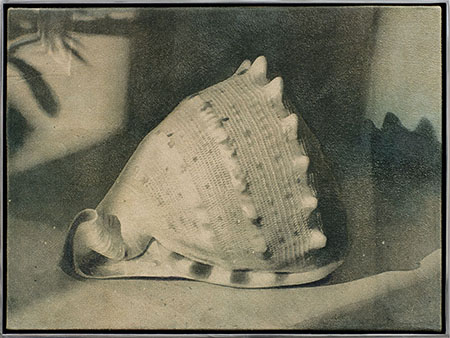
Continuing through January 28, 2023
At first glance, Poppy Jones' small, intimate, single hue paintings appear to be photographs. They are close-cropped depictions of everyday things — jackets, folded shirts, boots, flowers, lamps, a candle, and most beautifully, a page from a spiral-bound notebook covered in shadows. They feel like contact prints from vintage negatives that have been selectively hand colored.
For Jones’ current exhibition, “Body & Soul,” as in her past installations, the works are hung to give each ample space and presented in a line along the gallery walls. They read as a quasi-narrative. The first (or last) image in the sequence is “Shell,” a realistically rendered conch shell resting on a table in front of a darker-toned vase. The shell approximates its "actual" size, filling most of the 7 5/8 by 10 1/4 inch canvas. A light source outside the frame illuminates the scene, creating a fluted shadow on an adjacent wall. Because it is painted on suede (Jones sometimes cuts up her own garments or uses fabrics such as suede, silk, or cotton as a surface), there is an unevenness to the ground that in this case accentuates the texture of the shell. Jones' focus is on the way light illuminates objects, and while she depicts fragments and interior scenes, she is conscious of presenting moments that radiate quiet. Her "still lifes" are just that — still.
“Lumen,” “Interior (Evening)” and “Lux” are also painted on suede in singular sepia tones. In “Lux,” the metal arm of a floor or desk lamp enters near the bottom left side of the composition and extends toward the right across the frame. Jones depicts the bright glow of a light bulb housed within the shade in contrast to the black of the lamp and the gradient of mid-tones on the wall behind. There is nothing else in the picture. “Interior (Evening)” and “Lumen” are more graded. In these subtle reductionist paintings little differentiates the object from the background. As if created in low light, Jones delineates the shapes of a candle as well as the shade of a table lamp filling the image with a soft, glowing aura.
While none of the paintings are figurative, the human presence is alluded to. Folded jackets or shirts fill the space in “Dawn,” “Mortal Form (Autumn),” “Mortal Form (Spring),” “Sea Weather” and “Summer Leaves.” Titled after seasons, times of day, or the elements, these works are a combination of painted fabric (stripes, quilted down) and the marks or shadows that happen to fall on them. The pieces beg questions — whose garments? Are they in use or discarded? Where and how are they placed to capture the light and shadow? One of the pleasures in regarding the work is to imagine the scene beyond the image. For example, in “Glass/Edge,” who left the empty wine glass on the edge of the banister and why?
Jones' works are skillfully painted, they resonate beyond their formal qualities. It is not surprising that she draws from literature where descriptions of rooms and objects allude to ideas beyond. A previous exhibition was titled "Cutting Shade,” after a verse in a Gertrude Stein poem. This exhibition references Virginia Woolf's "To the Lighthouse," pointing to the silence of dilapidated spaces. Like Woolf, Jones brings inanimate objects to life. She captures indistinct moments and imbues them with memories. Her paintings give a delicate presence and a satisfying permanence to innocuous objects and fleeting events that might otherwise be overlooked. These small works have an expansive intimacy and a lasting aura.
